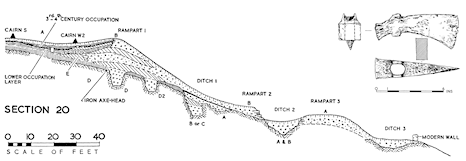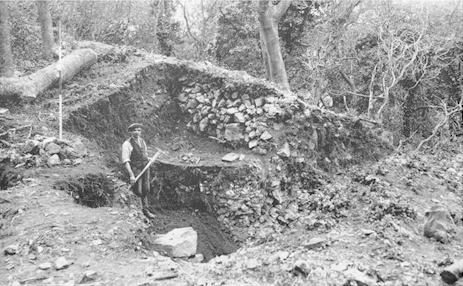

Substance can be added to these generalised insinuations of inferior work on behalf of some early excavators by recounting the gist of an unfortunate incident that serves to show how lack of attention to detail in excavations, especially in those conducted insensitively, can reap undesirable consequences quite unimagined by those involved. Just how matters could go horribly wrong is well illustrated by a seemingly crucial artefact — an iron shaft-hole axe-head — unearthed in 1922, during excavation of Gardner's Section 20, near the south-west corner of Dinorben (Figure 5). Ostensibly, the axe was found on the berm separating the bank and ditch thought (correctly) by Gardner to have been primary to a complex and prolonged development of prodigious earthworks traversing the neck of the promontory. At first, Gardner was quite assertive over both that stratigraphical position and the age of the axe (broadcasting them prompt and wide — 1922; 1923a; 1923b). He regarded it as 'a native type current in Britain during the centuries immediately before and subsequent to A.D.' (Gardner 1923a) and hence not inappropriate in the context of a relatively early phase of the hillfort, and he had little doubt of either the 'forcible destruction' of that 'first hill-fort' or that this 'was the work of Roman legionaries invading the district', leaving three later buildings of the defences to be attributed to the centuries of Roman dominance. As time passed, Gardner seems to have lost faith in parts of that scenario, and had apparently grown cooler towards the alleged significance of the axe, affording it no mention in his mature summarising of the Dinorben excavations, by then referring to an 'absence of definitely datable relics' in connection with the 'earlier forts' (1926; 1947). In contrast, when Savory came to examine Gardner's results, in company with those of his own 1956-61 programme of multiple trenching in other areas of the same hillfort, he was content to endorse Gardner's early understanding of both the 'clear stratification' of the axe and its relevance for the history of defence-building there, and was himself inclined to ascribe the axe to the Iron Age and the 1st century BC (Gardner and Savory 1964, 42, 83-4, 155). Certain reviewers, however, were openly hostile, asserting the axe to be of Roman manufacture, and hence deducing that its recorded provenance defied Savory's use of it in constructing a chronology for Dinorben's multi-period earthworks (Alcock 1965; Frere 1965). As the 1960s progressed, Savory's resumption of trenching into those earthworks gave him increasing confidence that their evolution had been largely prehistoric, so that, finally (1971a, 30), he felt compelled to conclude that the 1922 workmen must have been mistaken in the stratigraphical information communicated to Gardner regarding the axe — and we may wonder little at it, considering the disreputable state of that excavation (Figure 6; cf. Gardner and Savory 1964, pl. XIb).8

The crux of the matter is that, even where a find-spot and archaeological context may seem to have been recorded for certain artefacts, which may then come to be presented as pertinent to the dating of a carefully devised structural phasing, there remains the problem of knowing how much trust should be placed in the primary record. For almost 50 years, archaeologists working on Welsh hillforts, or at least those who took what they were told at face value, were led astray by this mishap at Dinorben, which evidently arose essentially through a lack of archaeological ability or discipline, but just possibly integrity (i.e. it is not hard to imagine Gardner's men receiving a larger gratuity for a find with close provenance than for one without), on the part of those employed to assault Dinorben's earthworks. Gardner and his hired hands performed an operation that may have been trumpeted as 'scientific' but which was really far removed from anything we would, or anyhow should, now deem acceptable in that guise.
It might be argued that due allowance ought to be made for the age and context of the various pieces of fieldwork debated so far, implying that each was perhaps as good as could be expected of its respective time. Of course, fairness alone would recognise an obvious truth in such a view, but sentiment should not be allowed to blind us to palpable defects in the evidence as envisioned and presented. Rather, it is necessary to remain ever circumspect in handling information recovered by such insensitive means, especially where seemingly pivotal observations are not corroborated by repeated patterning within a wider set of data retrieved from a given site. It should not be forgotten that the sting in the lengthy tale of Dinorben's 'stratified' axe came about solely because, fortunately, opportunities for procuring new evidence were grasped long after the 1922 'misunderstanding' occurred (and before this hilltop too was entirely razed by quarrying), so exposing the old falsehood. Bearing in mind that the true age of that axe would eventually have transpired regardless of other events, had those renewed excavations not happened, we might still be labouring under the delusion of a reputed archaeological 'fact', appearing to prove that Dinorben hillfort was very largely a work of the Romano-British centuries, and maybe later (see Dinorben).
Let it not be assumed that this will necessarily be a solitary case of corrupt information from the excavation of a hillfort, whether at Dinorben or elsewhere. It may be thought, or anyway we might care to think, that such canards are most likely to have entered the literature by way of fieldwork belonging to those early days of the developing discipline of archaeological excavation. It is as much for this as for any other reason that we should be cautious of taking literally such claims as that of Ffoulkes (1850) regarding recovery of a 'Roman' potsherd from 'under the rampart' of Moel Fenlli. At any rate, the salutary story of Dinorben's iron axe forces us to accept that some proportion of supposed archaeological 'facts' relating to hillforts (and not just hillforts) are actually no better than 'factoids', i.e. imagined information or, worse, contrived disinformation.9 Our difficulty lies in distinguishing factoids from facts. It can but be hoped that, with time and with more exacting excavation, a consistency in the chronology and development of hillforts in Wales (as elsewhere) will gradually emerge, sufficient to facilitate isolation of dubious anomalies, so that the gross record can more nearly be rid of misfits.
Internet Archaeology is an open access journal based in the Department of Archaeology, University of York. Except where otherwise noted, content from this work may be used under the terms of the Creative Commons Attribution 3.0 (CC BY) Unported licence, which permits unrestricted use, distribution, and reproduction in any medium, provided that attribution to the author(s), the title of the work, the Internet Archaeology journal and the relevant URL/DOI are given.
Terms and Conditions | Legal Statements | Privacy Policy | Cookies Policy | Citing Internet Archaeology
Internet Archaeology content is preserved for the long term with the Archaeology Data Service. Help sustain and support open access publication by donating to our Open Access Archaeology Fund.